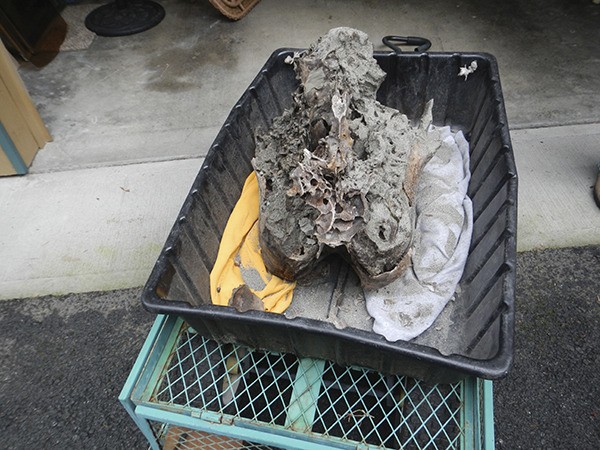The eroding bluffs surrounding Sequim Bay are providing a peek into times long ago — 50,000-100,000 years ago.
While walking state Department of Natural Resources-owned tidelands east of Sequim, local residents discovered a partial skull of what’s likely a Columbian mammoth emerging from the sandy wall. Since discovery of the fossil in early January, officials with the Burke Museum of Natural History and Culture have been working to collect the specimen for conservation and further analysis.
“The fossil likely represents a Columbian mammoth (Mammuthus columbi), as that’s the species typically found in this part of Washington,” Christian Sidor, Burke Museum curator of vertebrate paleontology, said. “The Columbian mammoth is the state fossil of Washington.”
Sidor and colleagues were able to collect the last of the remains Jan. 18.
“The fossil is currently undergoing conservation in our lab,” he said. “Once it is stabilized, documented and preliminarily studied, the Sequim Museum is interested in displaying the specimen. My goal is to work with the local museum to get the fossil on display soon.”
The exact age of the mammoth hasn’t been determined, but based on its size it’s estimated to be an adult.
The rocks surrounding the specimen date back between 50,000 and 100,000 years ago and represent a gravelly riverbed — giving hints as to why only the skull became unearthed.
“It follows that the animal must have died close to the river, been swept in (or scavenged), and then its skull was eventually buried,” Sidor said.
Because most fossils are isolated and broken, Sidor notes he’s not surprised that the found fossil is a partial skull.
“In fact, teeth are the most common part to be preserved because they’re durable and don’t have much nutrition value, so they aren’t destroyed by scavengers,” he said.
Weighing about 18,000-22,000 pounds, Columbian mammoths were one of the largest species of mammoth. They roamed North America, including present day Sequim, during the Pleistocene epoch. Although it’s difficult to know exactly what Sequim was like when the newly discovered mammoth was alive, Sidor said, Sequim was colder and drier 50,000-100,000 years ago.
Several other mammoth and mastodon fossils have been found on the Olympic Peninsula, but each one “provides an important piece of data on our region’s natural history,” Sidor said.
“One example of what we can learn from fossil occurrences like this one is that it helps us understand the timing of advance and retreat of glaciers during the last 100,000 years,” he said.
Fossil finds, what to do
When and if remains of any kind are discovered it’s important to ask yourself whether it appears to be an archeological site, said David Brownell, cultural resources specialist for the Jamestown S’Klallam Tribe. However, because it’s often difficult to determine the type and significance of remains, Brownell suggests to “err of the side of caution” and contact the Washington State Department of Archaeology and Historic Preservation in Olympia, at 360-586-3065.
Also, regardless of the age of the remains, if they appear to be human, law enforcement must be contacted.
Both Brownell and Judy Reandeau Stipe, Sequim Museum and Arts executive director, emphasize the importance of not removing any remains from their location, as it may be illegal and could interfere with future work and evaluation of the site.
“I would like to stress that vertebrate fossils are very rare and important objects that shouldn’t be viewed as trophies,” Sidor added.
Instead, by notifying officials with Department of Archaeology and Historic Preservation or the Burke Museum of found fossils, artifacts or unknown remains “assures that the scientific community can access the data contained within the specimen and that it is (made) available to the people of Washington,” he said.
Contact the Burke Museum at 206-543-5590 or Sequim Museum and Arts at 683-8110.



